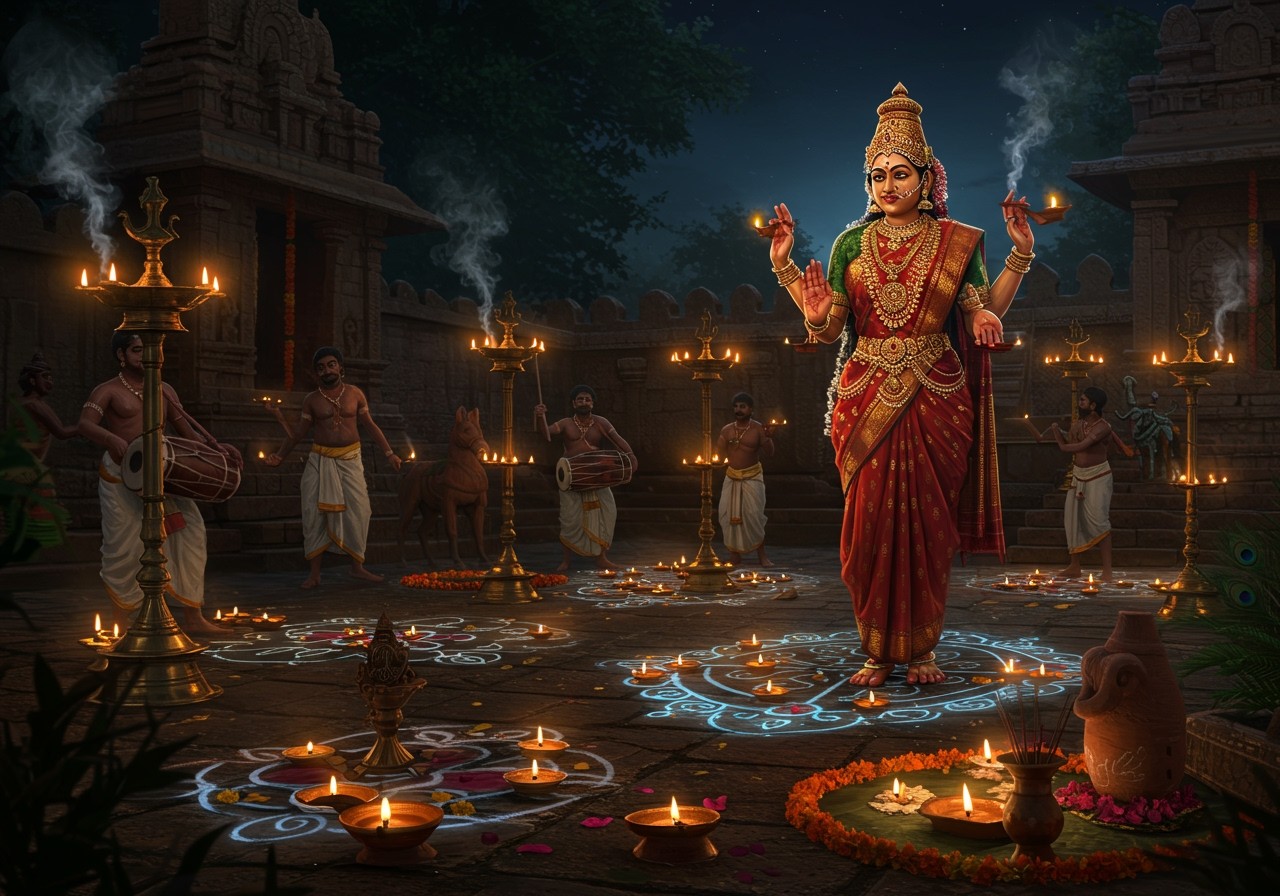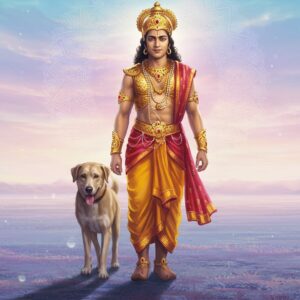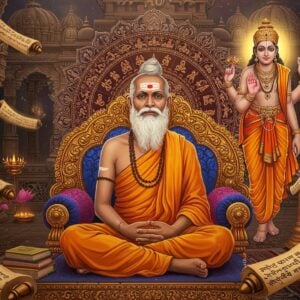
Dravidian folklore and traditions represent a vibrant tapestry of cultural practices, beliefs, and rituals, primarily found in South India. These traditions offer a unique perspective on spirituality, community, and the relationship between humans and the divine. Let’s delve into the key aspects of this rich heritage.
Core Beliefs and Practices
- Folk Religion: Dravidian traditions incorporate elements of animism, the belief that spirits inhabit natural objects, shamanism, ancestor worship, and reverence for the mother goddess. These practices are thought to predate significant Indo-Aryan influence, offering a glimpse into ancient spiritual beliefs. They highlight a deep connection with the natural world and the spirits that reside within it.
- Village Deities: The veneration of village deities and guardian spirits is a cornerstone of Dravidian folk religion. Aiyanar, often depicted as a fierce warrior riding a horse or elephant, is a prominent example. He is propitiated for protection against malevolent forces, demonstrating the importance of community guardians in Dravidian belief systems. People seek his blessings for safety and well-being.
- Female Principle: The cult of the Female Principle (Shakti) is central to Dravidian religion. Goddesses like Amman (also known as Mariamman or Durga), a powerful mother goddess, are worshipped as protectors of families, villages, and children. Her worship extends across the Tamil diaspora, sometimes blending with Vedic Hinduism and other faiths, showcasing the adaptability and enduring power of the mother goddess figure.
- Ancestor Worship: Reverence for ancestors is a key feature, with the deification of deceased family members and their commemoration through megalithic monuments. Hero stones (known as “Natukal” in Tamil, “Gandragallu” in Telugu, and “Virgal” in Kannada) memorialize those who died honorably in battle. These monuments serve as physical representations of respect for lineage and the enduring presence of ancestors in the lives of the living.
- Temple Worship & Rituals: South Indian Hinduism, deeply influenced by Dravidian traditions, emphasizes daily pujas (worship rituals), elaborate processions, and the adornment of deities. This contrasts with the Vedic emphasis on sacrificial rituals, highlighting the distinct character of Dravidian-influenced Hindu practices. The focus is on direct interaction with the divine through offerings and elaborate ceremonies.
Deities and Mythological Figures
- Murugan: Also known as Kartikeya or Subramanya, Murugan is a highly revered deity, especially in Tamil culture. He is worshipped as the god of war, victory, and wisdom. Considered the patron god of the Tamils, he is also called Tamil Kadavul (Tamil God). Murugan’s importance in Tamil culture reflects the deep integration of Dravidian traditions into Hindu worship.
- Amman: This powerful mother goddess, also referred to as Mariamman or Durga, is a manifestation of Parvati, Shiva’s consort. She is revered as the guardian of families, children, and villages. Amman’s role as protector underscores the importance of the feminine principle in Dravidian spirituality.
- Aiyanar: As a village guardian deity, Aiyanar is often depicted as a warrior mounted on a horse or elephant, safeguarding communities from evil spirits. His protective role emphasizes the importance of local deities in Dravidian folk religion.
- Kali: The fierce form of Parvati, Kali symbolizes the transformative power of destruction. She represents the cycle of creation and destruction and is revered for her power to overcome negativity.
Poojn.in offers a wide selection of products for devotees of these deities. Explore our collection of Bel malas, Tulsi malas, and other sacred items to enhance your devotional practices.
Rituals and Unique Beliefs
- Kavadi Attam: This ritualistic dance is performed by devotees of Lord Murugan as an act of penance and gratitude. It involves carrying ornate structures called kavadis, demonstrating dedication and devotion.
- Firewalking: Devotees walk barefoot across burning coals as a powerful display of faith. This act is believed to bring blessings and protection, demonstrating the intense commitment of believers.
- Pongal: A harvest festival celebrated by Tamils, Pongal involves preparing a special dish made from freshly harvested rice and offering it to the sun god Surya and other deities. It is a time of thanksgiving and community celebration.
- Theyyam: This ritualistic dance form from Kerala involves performers embodying divine spirits and offering blessings to the community. Theyyam combines elaborate costumes, music, and dance to create a powerful spiritual experience.
- Karagattam: A traditional folk dance performed as an offering to village deities like Aiyanar or Amman. This dance is a vibrant expression of devotion and community spirit. It features balancing pots on the head while performing intricate steps.
Dravidian Influence on Hinduism
- Fusion of Traditions: Hinduism is often described as an evolving river, absorbing elements from various cultures. The blending of Dravidian and Vedic traditions has significantly shaped the Hinduism practiced today. This fusion has created a rich and diverse religious landscape.
- Linguistic Influence: Sanskrit, the sacred language of Hinduism, contains words borrowed from Dravidian languages. Even the term “linga,” associated with Shiva, has Dravidian roots, demonstrating the deep linguistic interplay between these cultures. This linguistic exchange highlights the long history of interaction between Dravidian and Indo-Aryan cultures.
- Shiva’s Origins: Shiva’s origins are believed to be aligned with the yogic and ascetic traditions of the Dravidians, differing from Vedic gods like Indra and Agni. This suggests a distinct Dravidian contribution to the Hindu pantheon.
- Mother Goddess Worship: Clay figurines from the Indus Valley Civilization suggest an early reverence for the divine feminine, a tradition that continues in South Indian temple worship. The cult of the Sapta Matrika, or Seven Divine Mothers, may have Dravidian origins. This enduring reverence for the feminine divine highlights a key element of Dravidian spirituality.
Megalithic Culture
- Memorial Stones: Megalithic sites featuring umbrella stones, dolmens, and urns serve as memorials for the dead and expressions of ancestor worship. These structures offer valuable insights into ancient burial practices and beliefs about the afterlife. They provide tangible links to past generations.
- Menhirs: Huge pillars, known as menhirs, are erected in memory of the dead. These imposing monuments reflect the importance given to honoring ancestors and their continued presence in the lives of the living.
For those interested in exploring Dravidian architecture, Poojn.in offers informative articles on Dravidian and Nagara architecture and key features of Dravidian temples.
Unique Aspects
- Animism and Shamanism: Dravidian folk religion incorporates elements of animism (belief in spirits in objects and nature) and shamanism (communicating with the spirit world). These practices reflect a deep connection with the spiritual dimension of the natural world and the belief in intermediaries between the human and spirit realms. Shamans play a key role in healing and spiritual guidance.
- Materialism: Dravidian culture has been associated with an emphasis on materialism, valuing tangible possessions and economic prosperity. This aspect of Dravidian culture reflects a practical approach to life and a focus on worldly success alongside spiritual pursuits. It recognizes the importance of both material and spiritual well-being.
Learn more about Dravidian temples and their role in Hindu rituals and explore South India’s ancient temples at poojn.in.


